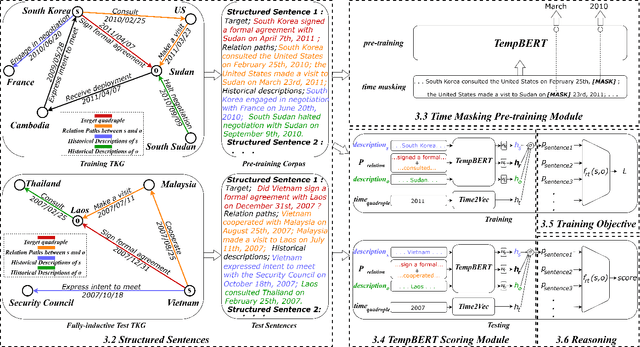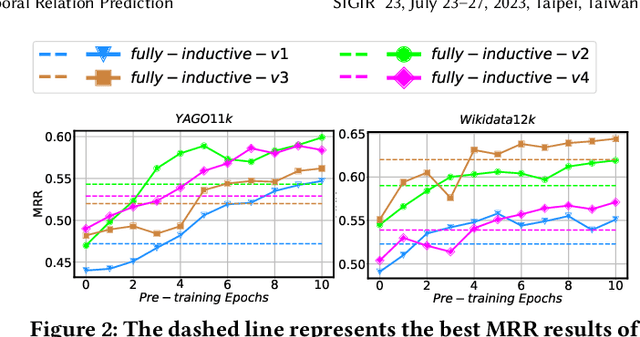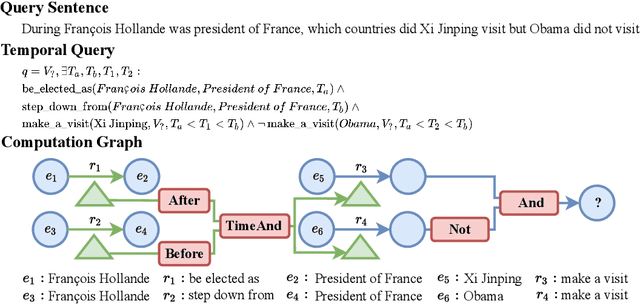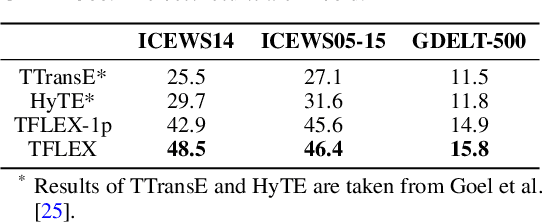Fenglong Su
Incorporating Structured Sentences with Time-enhanced BERT for Fully-inductive Temporal Relation Prediction
Apr 10, 2023



Abstract:Temporal relation prediction in incomplete temporal knowledge graphs (TKGs) is a popular temporal knowledge graph completion (TKGC) problem in both transductive and inductive settings. Traditional embedding-based TKGC models (TKGE) rely on structured connections and can only handle a fixed set of entities, i.e., the transductive setting. In the inductive setting where test TKGs contain emerging entities, the latest methods are based on symbolic rules or pre-trained language models (PLMs). However, they suffer from being inflexible and not time-specific, respectively. In this work, we extend the fully-inductive setting, where entities in the training and test sets are totally disjoint, into TKGs and take a further step towards a more flexible and time-sensitive temporal relation prediction approach SST-BERT, incorporating Structured Sentences with Time-enhanced BERT. Our model can obtain the entity history and implicitly learn rules in the semantic space by encoding structured sentences, solving the problem of inflexibility. We propose to use a time masking MLM task to pre-train BERT in a corpus rich in temporal tokens specially generated for TKGs, enhancing the time sensitivity of SST-BERT. To compute the probability of occurrence of a target quadruple, we aggregate all its structured sentences from both temporal and semantic perspectives into a score. Experiments on the transductive datasets and newly generated fully-inductive benchmarks show that SST-BERT successfully improves over state-of-the-art baselines.
Rethinking GNN-based Entity Alignment on Heterogeneous Knowledge Graphs: New Datasets and A New Method
Apr 10, 2023Abstract:The development of knowledge graph (KG) applications has led to a rising need for entity alignment (EA) between heterogeneous KGs that are extracted from various sources. Recently, graph neural networks (GNNs) have been widely adopted in EA tasks due to GNNs' impressive ability to capture structure information. However, we have observed that the oversimplified settings of the existing common EA datasets are distant from real-world scenarios, which obstructs a full understanding of the advancements achieved by recent methods. This phenomenon makes us ponder: Do existing GNN-based EA methods really make great progress? In this paper, to study the performance of EA methods in realistic settings, we focus on the alignment of highly heterogeneous KGs (HHKGs) (e.g., event KGs and general KGs) which are different with regard to the scale and structure, and share fewer overlapping entities. First, we sweep the unreasonable settings, and propose two new HHKG datasets that closely mimic real-world EA scenarios. Then, based on the proposed datasets, we conduct extensive experiments to evaluate previous representative EA methods, and reveal interesting findings about the progress of GNN-based EA methods. We find that the structural information becomes difficult to exploit but still valuable in aligning HHKGs. This phenomenon leads to inferior performance of existing EA methods, especially GNN-based methods. Our findings shed light on the potential problems resulting from an impulsive application of GNN-based methods as a panacea for all EA datasets. Finally, we introduce a simple but effective method: Simple-HHEA, which comprehensively utilizes entity name, structure, and temporal information. Experiment results show Simple-HHEA outperforms previous models on HHKG datasets.
Meta-Learning Based Knowledge Extrapolation for Temporal Knowledge Graph
Feb 11, 2023Abstract:In the last few years, the solution to Knowledge Graph (KG) completion via learning embeddings of entities and relations has attracted a surge of interest. Temporal KGs(TKGs) extend traditional Knowledge Graphs (KGs) by associating static triples with timestamps forming quadruples. Different from KGs and TKGs in the transductive setting, constantly emerging entities and relations in incomplete TKGs create demand to predict missing facts with unseen components, which is the extrapolation setting. Traditional temporal knowledge graph embedding (TKGE) methods are limited in the extrapolation setting since they are trained within a fixed set of components. In this paper, we propose a Meta-Learning based Temporal Knowledge Graph Extrapolation (MTKGE) model, which is trained on link prediction tasks sampled from the existing TKGs and tested in the emerging TKGs with unseen entities and relations. Specifically, we meta-train a GNN framework that captures relative position patterns and temporal sequence patterns between relations. The learned embeddings of patterns can be transferred to embed unseen components. Experimental results on two different TKG extrapolation datasets show that MTKGE consistently outperforms both the existing state-of-the-art models for knowledge graph extrapolation and specifically adapted KGE and TKGE baselines.
TFLEX: Temporal Feature-Logic Embedding Framework for Complex Reasoning over Temporal Knowledge Graph
May 28, 2022



Abstract:Multi-hop logical reasoning over knowledge graph (KG) plays a fundamental role in many artificial intelligence tasks. Recent complex query embedding (CQE) methods for reasoning focus on static KGs, while temporal knowledge graphs (TKGs) have not been fully explored. Reasoning over TKGs has two challenges: 1. The query should answer entities or timestamps; 2. The operators should consider both set logic on entity set and temporal logic on timestamp set. To bridge this gap, we define the multi-hop logical reasoning problem on TKGs. With generated three datasets, we propose the first temporal CQE named Temporal Feature-Logic Embedding framework (TFLEX) to answer the temporal complex queries. We utilize vector logic to compute the logic part of Temporal Feature-Logic embeddings, thus naturally modeling all First-Order Logic (FOL) operations on entity set. In addition, our framework extends vector logic on timestamp set to cope with three extra temporal operators (After, Before and Between). Experiments on numerous query patterns demonstrate the effectiveness of our method.
Time-aware Graph Neural Networks for Entity Alignment between Temporal Knowledge Graphs
Mar 13, 2022



Abstract:Entity alignment aims to identify equivalent entity pairs between different knowledge graphs (KGs). Recently, the availability of temporal KGs (TKGs) that contain time information created the need for reasoning over time in such TKGs. Existing embedding-based entity alignment approaches disregard time information that commonly exists in many large-scale KGs, leaving much room for improvement. In this paper, we focus on the task of aligning entity pairs between TKGs and propose a novel Time-aware Entity Alignment approach based on Graph Neural Networks (TEA-GNN). We embed entities, relations and timestamps of different KGs into a vector space and use GNNs to learn entity representations. To incorporate both relation and time information into the GNN structure of our model, we use a time-aware attention mechanism which assigns different weights to different nodes with orthogonal transformation matrices computed from embeddings of the relevant relations and timestamps in a neighborhood. Experimental results on multiple real-world TKG datasets show that our method significantly outperforms the state-of-the-art methods due to the inclusion of time information.
 Add to Chrome
Add to Chrome Add to Firefox
Add to Firefox Add to Edge
Add to Edge